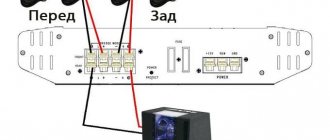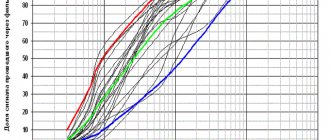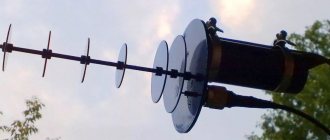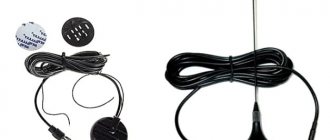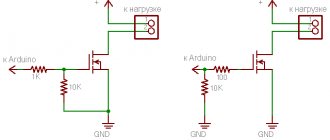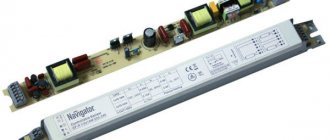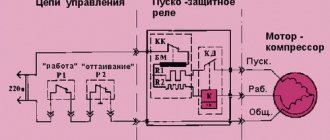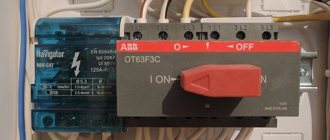What could be easier than connecting a single-coil subwoofer to a monoblock or multi-channel amplifier. It's a completely different matter if the subwoofer has two voice coils or two or more of them. A two-coil subwoofer, as well as two, three or more subwoofers, can be connected in four ways: each coil separately, parallel connection of coils, serial and combined. What each of these subwoofer switching options gives is, first of all, versatility, different capabilities. Let's consider each option separately. But first of all, you need to understand what happens when the coils are connected in parallel or in series. When the coils are connected in parallel, the total resistance, roughly speaking, becomes half as much. For example: if we connect two 4 Ohm coils in parallel, we get a total resistance of 2 Ohms, if we connect two 2 Ohm coils, we get a total resistance of 1 Ohm.
The opposite effect occurs with a series connection. When connecting two 4 Ohm coils in series, we get a resistance of 8 Ohms, when connecting two 2 Ohm coils, we get 4 Ohms. etc.
-Connect each coil separately. This option allows you to connect a powerful two-coil subwoofer to a less powerful four-channel amplifier if it is not possible or not possible to purchase a powerful monoblock. Naturally, the resistance of the coils must correspond to the operating load of the amplifier in a bridge connection and the GAIN controls must be at the same level.
-Parallel connection of coils - subwoofers. As described above, when connected in parallel, the resistance is halved, allowing the amplifier, operating at a lower load, to deliver more power. But as they say, “if it leaves somewhere, it will definitely arrive somewhere.” In this case, this is true, only on the contrary, the power has increased, and the amplifier’s control over the subwoofer has decreased, as a result of which the bass becomes smeared.
-Serial connection of coils. If the amplifier is powerful, why not, increase the impedance (resistance) and get a more developed bass. I would also like to add that if the resistance of the connected coils exceeds the permissible load of the amplifier, this is not at all scary, it’s just that the output power of the amplifier will be less. Let's say an amplifier with a declared operation for a load of 4 ohms produces 500 watts, and with a load of 8 ohms, for example, it will produce 350 watts.
-Combination connection. Subwoofers are coils that are simultaneously connected in serial and parallel connections for switching to a specific load. There are a great many connection options, it all depends on the number of subwoofer speakers, the resistance of the subwoofer voice coils and the capabilities of the amplifier.
Everything in this entry is written with some sarcasm, please don’t be offended, but I hope it’s written in more detail. I myself am only an amateur and am just discovering car audio. I remember how I bought my first used sub and searched on the Internet for how to make it all work. That’s why I created this hopefully useful post for someone! The photos are taken from the Internet, not everything on them is really done correctly, but for a general concept or example I think it will be enough!
Read more: Vk technology pads reviews
We listened and listened to music and suddenly I wanted to put a subwoofer in my car. I bought myself a used one, or in a Mystery store, or a prologie, or even some kind of supra, and if I forked out money and bought a pioneer, it’s absolutely beautiful)))) (sarcasm) because pay attention to Alphard, Ural, Pride, etc. This is really excellent sound, quality and reliability, but also the price accordingly. Currently, Alphard is one of the leading companies on the Russian market. This hardware is used to set world records! Who is interested, there is a channel of this company on YouTube - - - - - - - - - - - Alphard Group www.youtube.com/channel/UC8TvJkVR14JsAXkpA59j2QA another one of the coolest channels LOUD SOUND www.youtube.com/channel/UCPXf2nu1pPxEbzbc6YmZbSw who is interested in car audio - Come watch it, it's very exciting content! With all this, they often give away hardware for your car!
I read on the Internet that it won’t play from a radio, so we bought ourselves an amp of even the same brand
and the wires are “cool”
and the question arose: how to connect all this?!
wire kits usually have this kind of arsenal inside.
Initially we need to run a power (positive) cable from the battery. neither from the cigarette lighter, nor from the brake lights or whatever else you come up with, but from the battery we pull it to the trunk or wherever you have an amplifier wire. at a distance of about 10 cm (the closer to the battery, the better), cut the wire and insert a fuse there.
next you need to take a minus. since the system is weak, you can take it from the body of the car, BUT do not think that these are trifles and it is better to screw the minus to the seat mounting BOLT or something else serious than to twist it. because with poor contact these wires heat up well. and let me not tell you what heated wires in a car can lead to.
Then you have a blue wire, so thin, in most cases, REM. We connect it to the rear of the radio. A blue wire comes out of the radio chip; most often it is not connected to anything. This blue wire receives 12V from the radio when it is turned on. Amplifiers and active antennas are connected to it. Thus, when you turn on the radio, your amplifier antenna, etc., starts up. When you turn it off, everything turns off. In the same place, if there are outputs on the radio, we also connect the interblocks. Then we lead these 2 wires also into the trunk to the amplifier.
How do I connect all these wires to the amplifier?
it's simple. the power cable (+) is connected to terminal 12+. negative to the GND terminal. The REM wiring is connected to the RMT or REM terminal. everything is as in the example.
Nearby you have terminals + - + - this is the connection for the speakers. This amplifier has 2 pairs of such pins. This is a 2 channel amplifier (for 2 speakers)
By the way, the interconnects, if you haven’t guessed it yet, are connected to the back of the amplifier, where there are a bunch of knobs and switches for adjusting the amplifier.
THERE ARE other cases when I bought everything and the question arose: where to insert the interconnect if the radio is old or standard and does not have RCA outputs at the rear? then something like this adapter or whatever you call it will come to your aid. In this case, you will not need an interconnect, but will need to take 4 wires from the radio. + and - left + and - right speakers, lead them to the amplifier and connect the adapter to this.
Read more: How to find out your car tax
so, now you can check everything and try to run it. Is the green light on the amp on? I'm happy for you. the most important thing you have done. now it's a matter of setting up the basic settings are as follows: the amplifier has several regulators 1. GAIN, LEVEL, they are also volume, capability. you expose it to your ears. add until the speakers start farting and back a little. 2. LPF, LOW PASS, SUBSONIC filter that cuts the low frequencies of the subwoofer. those. Adjusts how low the bass will be played by the sub. It is advisable to display this setting closer to the parameters of your subwoofer. if the subwoofer says the frequency range is 40-500 hertz, then it’s better to cut it to 60 hertz from below at least because those subs above in any case don’t play half of what is written on the box, and if they do, they don’t play for long. 3. HPF, HI PASS filter which cuts off the high frequencies from your speakers. those. It prevents your speakers from squeaking. In principle, it is not necessary to cut off the top from your centers, but for better quality and more precise tuning it is better to do this. of course, if you have something to squeak in the car (tweeters) 4. BASS SOOST, it’s better not to twist the guys. only as a last resort, if there is not enough amplifier power, you can add a little. but try to keep this matter to a minimum. Well, and the switch itself. when LP/LPF is turned on, the low-pass filter (for the sub) will work; when HP/HPF is turned on, the high-pass and low-pass filter will work. those. you cut off the top from the middle so that they do not squeak and the bottom so that they do not reproduce those frequencies that it would be better to let the sub. FLAT is, so to speak, reproduction without filters. those. The sound is directly fed to the speakers and they play the entire frequency range. those. and the subs will bass and try to sing the melody to you and the mid-range speakers will sing and fart from the bass)
“Every little one knows, black is a minus, red is a plus!”
Connecting a subwoofer 2 X 2
Low-frequency systems with two loudspeakers are often installed in cars. They provide great power, deep and rich bass. The connection diagram for a 2 X 2 subwoofer may differ from other options. This design can be made in the form of a closed box or work with a bass reflex. Connecting a 2 X 2 subwoofer can be done in two simple ways. This is a series or parallel connection of loudspeaker voice coils. In order to calculate the resulting resistance, a simple formula is used. The voice coil winding is a low-resistance resistor. When two 2 Ohm coils are connected in series, the total resistance is 4 Ohms, based on the formula R total = R1 + R2 or 2 Ω + 2 Ω = 4 Ω.
The connection diagram for a 2 X 2 subwoofer at 4 Ohms does not cause any difficulties, since almost all low-frequency amplifiers operate with such a load. The formula for parallel connection of resistances looks a little different. Here the resulting resistance of several resistors will be less than the smallest resistance of the parallel circuit. According to the formula Rtotal=R1*R2/R1+R2, the resistance of two 2 Ω coils connected in parallel will be equal to 1 Ω. Connecting a 2 X 2 in 1 subwoofer is associated with some difficulties, since not all models of low-frequency amplifiers can work correctly with such a load impedance. Each connection has its own specifics. If in the subwoofer connection diagram there are 2 X 2, the windings of the voice coils are connected in series, then the power will decrease by about half. Since one speaker with an impedance of 2 provides a nominal power of 500 watts, connecting a second speaker in parallel with the same impedance will reduce the system output power to 350 watts.
How to connect a 1 ohm subwoofer
The subwoofer connection diagram in 1 ensures maximum power from the low-frequency unit and the highest volume level. However, the quality of bass reproduction will not be the best. Low frequencies will be “smeared out”. As the load resistance of the amplifier increases, the power will decrease, but the quality of low-frequency reproduction will noticeably increase. The blurriness of the sound will disappear, and the bass will become clear and deep. You cannot connect a 1 Ω subwoofer to every amplifier model. The description of some low-frequency units specifically stipulates the minimum permissible load resistance. Loudspeakers with a 1 Ω coil are rare, so this resistance is usually obtained by connecting two 2 speakers in parallel. Connecting a 2 X 2 in 1 Ohm subwoofer can be done by using one speaker with two 2 Ω windings. They always indicate the polarity. In order for the speaker system to work correctly, you need to connect the speaker contacts correctly.
The pros and cons of the voice coils are interconnected and connected to the corresponding contacts of the low-frequency amplifier.
How to setup
The car owner, having installed the unit, configures the operating parameters in accordance with the documentation attached to the product. The methodology and specifics of tuning depend on the technical characteristics of the equipment and the personal perception of the sound picture by the tuner. If the user is not confident in his own abilities, then it is recommended to contact a specialized center that installs and configures car acoustic systems.
To set up an amplifier connected to standard speakers, you will need to follow these steps:
- Select the high pass filter level at 60-80 Hz.
- Set the Gain sensitivity control to the minimum position, and then increase the volume level on the head unit to maximum. Start gradually increasing the Gain level until noise or distortion appears in the broadcast sound.
- Set the volume parameters based on your own perception. Additionally, it is possible to adjust the frequency cutoff value specified by the filter. To improve the sound picture, it is possible to activate the low frequency enhancement mode (bass boost).
If the amplifier circuit is also connected to a subwoofer, then it is necessary to limit the high frequencies using a high-pass filter. When setting, a value within the range of 50-80 Hz is selected. If the car uses a subwoofer with a bass reflex, then a subsonic corrector is used for adjustment. Some amplifiers use an additional phase corrector, which makes it possible to coordinate the operation of the subwoofer with the rest of the speakers.
How to connect a 4 ohm sub
Connecting a subwoofer at 4 is considered the most common, since most dynamic heads have such resistance, and all types of low-frequency amplifiers allow the use of such speakers as a load. You can organize a 4 ohm load using two 2 ohm speakers connected in series, when the plus of one speaker is connected to the minus of the other. The connection diagram for a subwoofer in 4 can be obtained using a two-winding speaker. Depending on their resistance, the connection configuration depends. Two coils of 8 connected in parallel will give, as a result, the required 4 Ohms. The same resistance is obtained if two voice coils with a resistance of 2 ohms are connected in series.
In the connection diagram for a subwoofer in 4, the minus of one voice coil is connected to the plus of the other winding, and the remaining free contacts are connected to the output of the low-frequency amplifier, observing polarity. Connecting two subwoofers of 4 is carried out in parallel or in series. Connecting a subwoofer 4 4 in 2 will provide increased power almost twice. The series resistance of the windings will be 8 Ω. The power will be reduced, but the bass performance will be bright and clear.
How to connect a sub to a monoblock
September 19, 2021 When building an audio system, a situation may arise when the existing speaker has a resistance that is less or more than what the amplifier allows. If you have two similar speakers, you can simply connect them in series or parallel and get the desired impedance.
However, in practice (especially for car audio), other more exotic scenarios are more common, for example, a subwoofer with two coils, or a powerful amplifier and two not very powerful subwoofers. There are many connection options and this raises questions for many. Here are some of the most common subwoofer connection diagrams.
I will add that for high-quality sound it is advisable to use identical subwoofers. Also, if you have the opportunity to use one source instead of two, it is advisable to do so - in most cases, one source sounds better than several. Exceptions are specialized schemes in which the relative position of sources, interference, the shape of the wave front and the like are specially calculated.
To begin with, the simplest option.
Connection options for single coil subwoofers
In most cases, for subwoofers with one coil, everything is more or less obvious, so further we will consider only subwoofers with two coils.
How to connect a two-coil subwoofer
Connection diagrams for a two-coil subwoofer are limited to the following several options:
- Parallel connection
- Serial connection
- Separate connection
Most often, the resistance of the windings of low-frequency speakers is 2 or 4 ohms. With a parallel connection, the total resistance will be half the resistance of each winding. It will be 1 or 2 respectively. A series connection will give a resistance of 4 or 8 Ω. By reducing the output power, the best sound quality is achieved at low frequencies. In addition, you can connect a subwoofer with two coils without connecting them, but by using each winding for a separate channel of the low-frequency amplifier. Connecting 2 coil subwoofers must be done with strict observance of polarity. It would be undesirable for an amplifier to connect a 2 Ohm subwoofer in a bridge connection.
Each amplifier channel will operate at 1 Ω, and this is a dangerous load for some models of low-frequency equipment. The power will increase, but at the same time the current will increase and nonlinear distortion will increase. The ULF output stages will operate in a critical mode and may fail. Separate connections are allowed only if absolutely the same signal is supplied to both channels of the amplifier.
Connecting the subwoofer to the radio
It is necessary to connect the subwoofer to the radio only through an amplifier. Since the built-in power of the radio is not enough for the subwoofer to work properly, you will not get normal bass. The connection chain is simple: radio-amplifier-subwoofer. The radio transmits the signal to the amplifier. The amplifier, in turn, amplifies this signal and sends it to the subwoofer.
What is an amplifier for?
The amplifier is used to increase the volume headroom, reduce distortion and improve the sound quality of music. The built-in amplifier of the radio is not enough to drive a heavy low-frequency speaker, which will cause large distortions, the volume level will be low and, with a high probability, the subwoofer may fail or simply “burn out.”
Read more: Road sign 2 5 tons
If you have an active subwoofer, then you will not need an additional amplifier, because it is already built into the subwoofer housing (more about active subwoofers). For a passive subwoofer you will have to choose an amplifier (read how to do this correctly on this page).
How to connect a 2 to 2 sub
The connection diagram for a 2 Ohm subwoofer is carried out according to the classical scheme, when the speaker coil is connected to a low-frequency amplifier. It is better to connect a 2 Ω subwoofer, consisting of one loudspeaker, to a separate ULF channel, since when bridged, the low resistance of the coil can damage the system. In addition to a subwoofer with one speaker, a system of two separate 2 Ohm loudspeakers or a two-winding dynamic head can be used as a ULF load. By combining the connection of the voice coils you can connect a 2 2 in 4 ohm subwoofer. To do this, they need to be connected in series. Connecting 2 x subwoofers 2 2 is carried out with a large-section multi-core acoustic cable to avoid power losses due to heating of the connections. In order to connect two 1 ohm subwoofers, the 2 ohm voice coils must be connected in parallel.
Three-way front and subwoofer
You can safely connect loudspeakers to an amplifier with an output voltage of 30V, but the loss of power in actual volume will be completely unacceptable. However, such inclusion is not used in first-order filters, since in this case an AC short circuit will occur at frequencies above or below the cutoff frequency, respectively. When connected in series, the phasing of the speakers will be slightly different. It is much more difficult if there are two voice coils or you need to connect several subwoofers.
The main feature of broadcast systems is the use of a matching transformer in the amplifier, which outputs a signal with level B into the line; in some cases it can be 30V, V, but we will consider these cases separately.
The improved car audio connection diagram involves the use of 3 toggle switches, one 2-pin and two 6-pin. Mid-range speaker 15GD
Knowing the intricacies of all the ways to connect speakers to each other and other participants in the speaker system, it is easy to accurately calculate all the real parameters of the devices used.
Ease of installation does not mean that the sound will be of poor quality. Connecting speakers.
Turn the adjuster slightly in the opposite direction. In fact, using this parameter for practical purposes is quite problematic when it comes to multi-way speaker systems.
For example, some of the acoustics can be turned on at full power, some at half and some at a third. How to connect 2 ohm speakers and how to connect a car audio speaker cable with your own hands
Subwoofer connection 1 1
The 1 Ohm subwoofer connection circuit is not used often, since, despite the high output power, this mode does not provide good quality reproduction of low frequencies. Some models of low-frequency car amplifiers do not allow the connection of such a small load at all. Connecting two 1 Ohm subwoofers is only allowed when the windings are connected in series. A resistance of 0.5 Ω, which is obtained with a parallel connection, can destroy the amplifier. A bridge switching circuit will reduce this value by another factor of two. When connecting a 1 Ohm subwoofer, you need to remember that as the resistance decreases, the current increases, so all connecting cables must have the appropriate cross-section. Do not use single-core wires or cables intended for electrical wiring to connect high-power speaker systems.
How to connect two subwoofers to one monoblock
An acoustic low-frequency system can consist of one or two speakers. Columns in which a larger number of loudspeakers are installed are used extremely rarely due to their large dimensions. The following amplification systems can be used to organize a low-frequency channel:
- Monoblock
- Two channel amplifier
- Four-channel ULF
A monoblock is a separate amplifier that works only on the low-frequency channel. The connection diagram for two subwoofers to a monoblock depends on the resistance of the voice coil winding. If it is equal to 4 Ohms, then both parallel and series connections of windings are allowed. As a result, the total resistance of the speaker system can be 2 Ohms or 8 Ohms. Connecting an 8 Ohm subwoofer provides the highest quality bass reproduction with a minimum of nonlinear distortion. This configuration is the safest for a low-frequency unit, since the currents in the amplifier circuits will be small and the elements of the output stages will not overheat. You can connect 2 subwoofers with speakers of 2 Ohms each to the monoblock. In this option, only a serial connection is allowed if the car uses an AB class amplifier. If the basis of the low-frequency system is ULF class D, then parallel connection of loudspeakers with a total resistance of 1 ohm is allowed.
In addition to speaker systems with two speakers, speakers with two windings are often used in low-frequency channels. Typically, such heads have a winding resistance of 2, 4 or 8 ohms. You can connect a two-coil subwoofer to a monoblock, as well as separate speakers, in several ways. Since there are two coils, their separate connection to the monoblock is impossible. To do this, you need to use a two-channel or four-channel amplifier. The connection diagram for a 2 X 2 Omak monoblock subwoofer allows parallel connection of windings for ULF class D and only serial connection for other classes of amplifier equipment. The most common mistake when connecting a 2 X 2 sub is using only one winding. Some people believe that there is only one channel in a monoblock and it is enough to connect only one winding. Testing of speakers with two coils and different connection schemes showed that when only one coil is connected to the output of a low-frequency amplifier, the sensitivity of the speaker system decreases by approximately 3 dB. Therefore, you can connect a subwoofer to a monoblock only by connecting both windings.
How to connect a subwoofer to an amplifier
Single channel connection
Connecting a subwoofer to an amplifier is not difficult; just connect the amplifier's audio output jack to the subwoofer coil or coils using speaker wires.
The wires should not be thin. In most cases, choose copper wiring with a cross-section of 4 mm and there will be no problems.
Connecting speaker wires
This subwoofer connection diagram is suitable for one channel of an amplifier or monoblock.
Monoblock is a single-channel amplifier designed specifically for subwoofers.
Connecting to a subwoofer via terminal block
Connecting to a subwoofer directly
Connecting a subwoofer with a bridge
In the case of using a multi-channel amplifier, the sub can be connected to two channels simultaneously, using the minus of one and the plus of the other, this connection is called bridged, with this method the power output by the amplifier increases significantly (see the specifications for specific numbers).
So you can connect a subwoofer to a two or four channel amplifier, using 2 channels for acoustics, and the remaining 2 for the subwoofer.
To connect a subwoofer with a bridge, make sure that your amplifier supports this feature.
If you connect a low-frequency speaker to an amplifier by changing the polarity, that is, connect the plus of the subwoofer to the minus of the amplifier output and vice versa, then the speaker will work in antiphase, there is nothing wrong with that, sometimes such a connection is used intentionally if the amplifier does not have phase adjustment (more about adjustment phases).
Connecting the subwoofer coils
The technical documentation for the subwoofer states the resistance of its coils (1 Ohm, 2 Ohm, 4 Ohm, rarely 0.5 Ohm), and the technical documentation for the amplifier indicates what resistance it can work with, this information is needed so that you connect correctly and effectively subwoofer to amplifier. The lower the resistance of the sub, the more power the amplifier will produce, provided that it can operate at this resistance. A subwoofer speaker may have several coils (1 or 2, rarely 4).
When the coils are connected in series, the resistance increases, while in parallel it decreases. If you don't want to learn definitions and count fractions, just save this cheat sheet (parallel and serial connections).
How much ohm to connect the subwoofer
The higher the resistance, the better the sound quality; the lower, the more power the amplifier delivers. If you need a lot of loud bass, then turn it to the minimum that the amplifier can provide, and if the overall sound quality of the system comes first, then it is 2 Ohms or 4 Ohms, depending on the power output.
Video on how to connect 2 subwoofers or more. Subwoofer connection diagram 2x2 Ohm, 4x4 Ohm, 1x1 Ohm. Serial connection of speakers. Parallel connection of speakers. Basic principles.
Happy connections!
Source: doctorbass.ru
